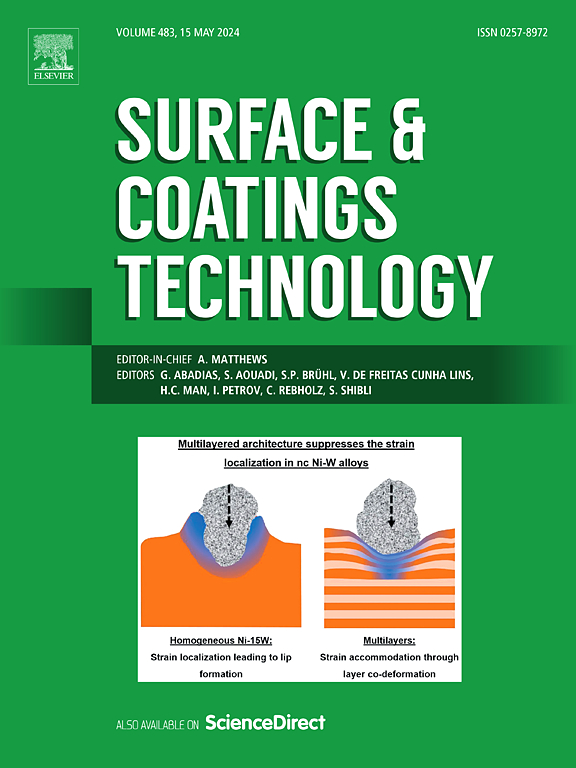Influence of fiber direction on the tribological behavior of carbon reinforced PEEK for application in gas turbine engines
IF 5.3
2区 材料科学
Q1 MATERIALS SCIENCE, COATINGS & FILMS
引用次数: 0
Abstract
The conditions under which materials are expected to perform in the next generation of gas turbine engines are becoming increasingly challenging. Consequently, proper material selection is essential for extending the service life of engine components. Polymer matrix composites (PMCs) offer an alternative to traditional metals and alloys due to their high strength-to-weight ratios; however, their use in harsh environments is still limited. Previous studies have extensively characterized carbon-reinforced polymer composites, highlighting the effects of parallel and anti-parallel fiber orientations on their mechanical properties and tribological behavior. However, recent advancements in PMC manufacturing have enabled the production of carbon-reinforced polyetheretherketone (PEEK) with fibers oriented normal to the surface. While this innovative technology shows promise with respect to mechanical properties, the tribological behavior of PMCs featuring normal fiber orientation has not been thoroughly investigated. This study aims to enhance the understanding of how fiber orientation influences the tribological performance of carbon-reinforced polymers. Friction and wear tests were conducted on CF-PEEK films with fibers aligned in the normal direction, and the results were compared to those of standard modulus carbon fiber/PEEK unidirectional tape (UD) and unreinforced, pure PEEK films under various contact conditions. Worn surface characterization was performed through ex situ analysis, utilizing techniques such as scanning electron microscopy (SEM), confocal laser scanning microscopy (CLSM), and atomic force microscopy (AFM) to reveal interfacial phenomena. A correlation between fiber orientation and wear and friction performance was established based on the different experimental parameters.
纤维方向对燃气轮机用碳增强PEEK摩擦学性能的影响
下一代燃气涡轮发动机的材料性能要求越来越高。因此,正确的材料选择对于延长发动机部件的使用寿命至关重要。聚合物基复合材料(pmc)因其高强度重量比而成为传统金属和合金的替代品;然而,它们在恶劣环境中的使用仍然有限。以往的研究广泛表征了碳增强聚合物复合材料,强调了平行和反平行纤维取向对其力学性能和摩擦学行为的影响。然而,PMC制造的最新进展使碳纤维增强聚醚醚酮(PEEK)的生产成为可能,其纤维取向与表面正相关。虽然这项创新技术在机械性能方面显示出前景,但具有正常纤维取向的pmc的摩擦学行为尚未得到彻底研究。本研究旨在加深对纤维取向如何影响碳增强聚合物摩擦学性能的理解。对纤维在法向排列的CF-PEEK薄膜进行了摩擦磨损试验,并与标准模量碳纤维/PEEK单向带(UD)和未增强的纯PEEK薄膜在不同接触条件下的摩擦磨损试验结果进行了比较。磨损表面表征通过非原位分析进行,利用扫描电子显微镜(SEM)、共聚焦激光扫描显微镜(CLSM)和原子力显微镜(AFM)等技术来揭示界面现象。基于不同的实验参数,建立了纤维取向与摩擦磨损性能之间的关系。
本文章由计算机程序翻译,如有差异,请以英文原文为准。
求助全文
约1分钟内获得全文
求助全文
来源期刊

Surface & Coatings Technology
工程技术-材料科学:膜
CiteScore
10.00
自引率
11.10%
发文量
921
审稿时长
19 days
期刊介绍:
Surface and Coatings Technology is an international archival journal publishing scientific papers on significant developments in surface and interface engineering to modify and improve the surface properties of materials for protection in demanding contact conditions or aggressive environments, or for enhanced functional performance. Contributions range from original scientific articles concerned with fundamental and applied aspects of research or direct applications of metallic, inorganic, organic and composite coatings, to invited reviews of current technology in specific areas. Papers submitted to this journal are expected to be in line with the following aspects in processes, and properties/performance:
A. Processes: Physical and chemical vapour deposition techniques, thermal and plasma spraying, surface modification by directed energy techniques such as ion, electron and laser beams, thermo-chemical treatment, wet chemical and electrochemical processes such as plating, sol-gel coating, anodization, plasma electrolytic oxidation, etc., but excluding painting.
B. Properties/performance: friction performance, wear resistance (e.g., abrasion, erosion, fretting, etc), corrosion and oxidation resistance, thermal protection, diffusion resistance, hydrophilicity/hydrophobicity, and properties relevant to smart materials behaviour and enhanced multifunctional performance for environmental, energy and medical applications, but excluding device aspects.
 求助内容:
求助内容: 应助结果提醒方式:
应助结果提醒方式:


